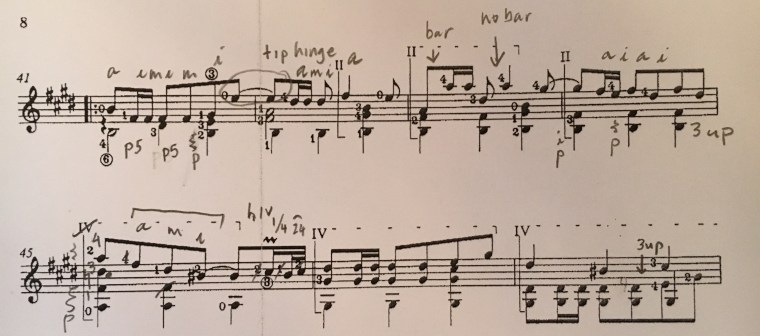I love the early stages of learning new repertoire because my ears, eyes, and fingers are most alert to discovery. My process of learning has evolved dramatically from when I first became afflicted with the classical guitar bug. For many beginners, the goal is simply to find a way to get the fingers to the right places and enjoy the results. As beginners approach basic fluency, the process of learning involves more and more layers of thought and reflection, of crafting and re-crafting, of listening and sculpting. As intermediate players reach a more advanced level, the amount of thought about what is going to occur on both a musical and physical level during the very early stages sets the stage for clean, efficient, and musical playing that seems seamless to the less experienced player.
Incorporating the following tips and principles will yield the best and most reliable results if they are incorporated in the early stages of the learning process. Exploring the ideas on repertoire that is already baked into your brain will take some careful and deliberate work to incorporate. Think of it like cooking a complicated dish, if all is measured carefully and timed precisely, the end result is wonderful. On the other hand, if you have forgotten to include ingredients in the baking process and attempt to salvage it by throwing in missing ingredients after the dish is done, the end result may not be as wonderful.
When learning a new piece, there is information absent from the score that if written in reminds you to weave them into your hand choreography when you practice. Below is a list that will help make both the left and right hands more efficient and two shots of a Scarlatti Sonata I just learned to illustrate how I label these items in a score. Assuming your basic fingerings are decided upon, incorporate the following ideas into your slow practice (and label them) to build a strong and reliable visual memory and choreography:
Right Hand
- Know when the fingers can plant or are laid out as an arpeggio (even though it may be the beginning of a scale passage).
- Know where your stability points are at all times. There should always be a right hand anchor in contact with the strings (usually p or a but possibly a combination).
- Insure string crossing is optimized and know when there are exceptions. See this early article for reference.
Left Hand
- Know when two fingers can place at once (usually in descending melodic fragments).
- Know when a finger can remain in place as an anchor and for how long.
- Know exactly what and why you are barring. Is it a hinge, partial, tip, cross, full, etc… (maybe there’s content for another post here!)?
- Know when a finger must lift from active duty to align or migrate to a new fret or to relieve tension. This sometimes means that theoretically a note may not last it’s full value.
- Know when you are shifting and/or expanding or contracting out of a standard relaxed position and for how long.
- Know your guide fingers (never shift without a guide or ghost guide finger).

Hope that helps you get to your musical goals sooner!
If you liked this article and would like more technique tips, check out Six String Journal’s publications! Please share, like, and comment!


Reblogged this on Six String Journal.
LikeLike